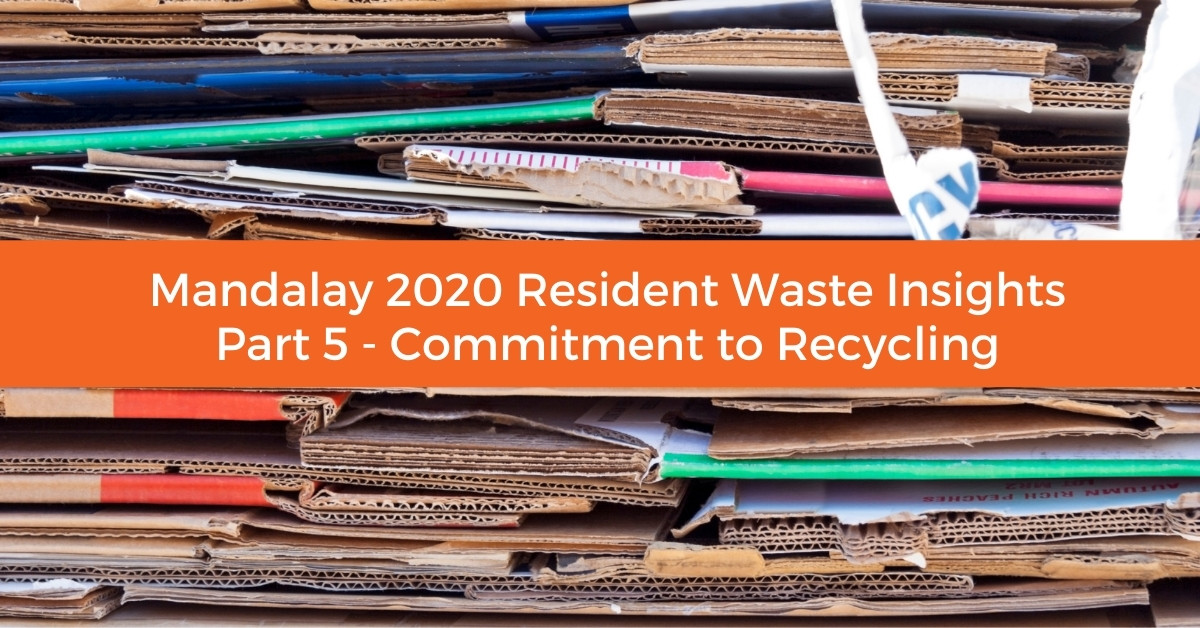
Australia’s commitment to, knowledge of and behaviours towards recycling
Recycling is a part of life, and as a member of the community, we each have a responsibility to follow through with recycling materials and participate in environmentally friendly behaviours when we can. But how much do residents across the nation really know about recycling, what kind of environmentally friendly actions do they take day-to-day and how committed are they to recycling – you may be surprised by the results.
About the Research
Here at Mandalay, we have collaborated with Footprints Market Research to undertake online research with over 1,500 Australians. Our goal is to help local councils across Australia gain a better understanding of waste and recycling behaviours. A portion of the data within this report has been interpreted in this blog. For even more insights, download a copy of the full Mandalay 2020 Waste Report.
What does the data tell us?
Commitment to recycling
Participants in this survey were asked about how committed they are to recycling. Most participants (73%) reported trying to do the right thing and recycle most of the time, while one in eight residents (12%) reported being completely committed to recycling and taking great care in putting only the correct materials into the recycling bin.
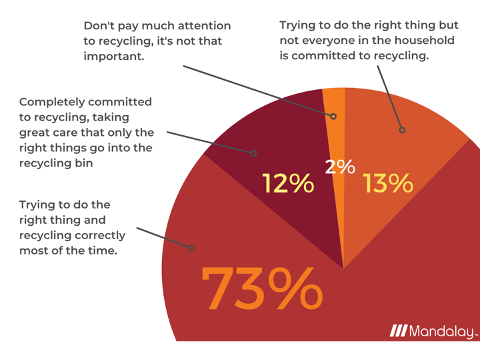
Commitment to recycling by demographics
A significant difference in commitment to recycling can be found once this data is broken down into demographics. Of the participants surveyed:
- 18 to 29 year-olds were 21% more likely to say that not everyone in the household was committed to recycling.
- 30 to 49 year-olds were 18% more likely to say that not everyone in the household is committed to recycling.
- 70 year-olds and over were 83% more likely to say they are trying to do the right thing most of the time.
Understanding what can be placed in the recycling bin
Participants surveyed were given a pre-selected list of items and asked whether they could be placed in the recycling bin. Of the participants surveyed, most were confident in recycling plastic bottles, food cans, magazines and pizza boxes. However, when it came to recycling aerosol cans and metal in general, there was still some confusions. Further, around a quarter of participants surveyed also wrongly believed that they can put soft plastics, such as plastic film and plastic shopping bags, in the recycling bin.
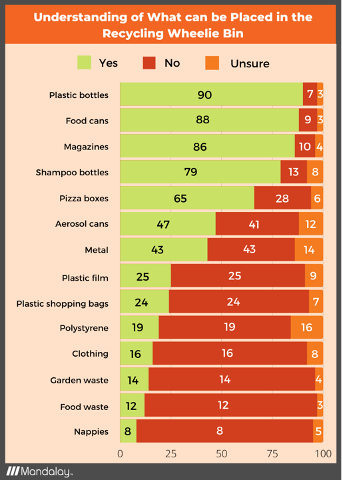
Around 19% of participants surveyed added more items to the above list that they were unsure about when it comes to recycling, including:
- broken glass
- china
- lightbulbs
- meat trays
- empty cleaning bottles
- bubble wrap
- coffee pods and takeaway coffee cups
- egg cartons
- long-life or tetra milk cartons
- plastic take-away containers or plastic trays
- plastic packaging or chip packets
- lids and bottle tops
- paper towels.
Other environmentally friendly behaviours
Aside from recycling, there is moderate uptake of other environmentally friendly behaviours being undertaken in the community according to this data. This includes making positive choices to purchase less packaging and/or purchasing products with recyclable packaging.
The only environmentally friendly behaviour that elicited the ‘rarely or never’ response from participants surveyed was for composting food scraps (39%). The two activities that dominated in the ‘often or almost always’ category was putting recyclables in the right bin (85%) and recycling cans or bottles (81%).
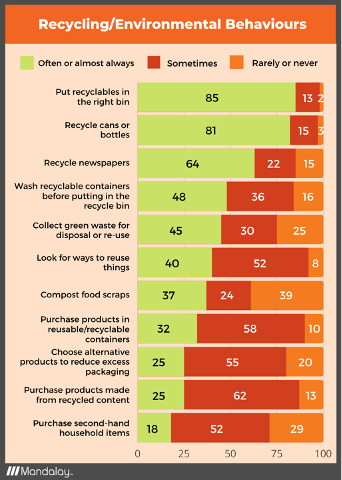
Environmentally friendly behaviours by demographics
Interesting insights can be found when looking at the same environmentally friendly behaviours across different age groups. Of the participants surveyed:
- Younger participants reported lower rates of recycling but higher levels of purchasing second hand and recycled goods.
- Participants in the 50 to 70 plus age range reported collecting green waste almost twice much as the younger demographics, and over 90% indicated that they almost always put recyclables in the right bin along with recycling cans and bottles.
- Participants in the 70 plus age range were also 30% more likely to wash out recyclables before putting them in the recycling bin compared to 18 to 29 year-olds.
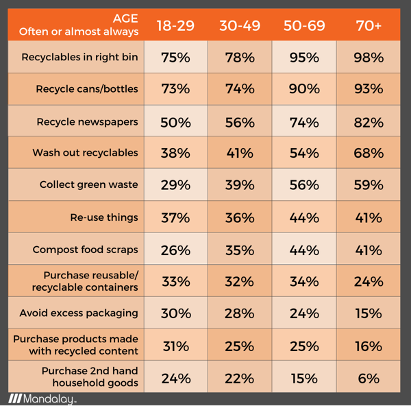
What can we learn from the data?
There are several opportunities to support our communities to increase their commitment to recycling more and recycling better. This includes delivering stronger education campaigns as well as supporting the harmonisation of services and advocating for more product stewardship schemes.
What the data tells us is that only 12% of participants surveyed were completely committed to recycling and taking great care in recycling only the correct materials, with most participants indicating they are trying to do the right thing and believing they are recycling right most of the time. While commitment levels to recycling are pointing in a positive direction, this suggests that participants are faced with doubt more often than not when it comes to recycling correctly. This was further substantiated with a worrying number of participants identifying many items that were not suitable for the recycling bin (e.g., plastic film, plastic shopping bags).
A small portion of participants surveyed even identified two big recycling blunders as being suitable for the recycling bin – food waste (12%) and nappies (8%). What’s more, 19% of participants surveyed identified additional waste items that they were unsure could be recycled (e.g., broken glass, meat trays, takeaway coffee cups). This data highlights a clear knowledge gap in the population when it comes to recycling and provides for opportunities for improvement. It’s a gap of comprehension, not intent.
While there is intent to recycle among residents and intent to do the right thing when it comes to recycling, there needs to be greater education around what can and cannot be recycled. When looking at targeted community populations to educate on recycling, it appears that residents between 18 and 49 years of age could be better informed on the types of materials that can be recycled. Those same residents may also benefit from gaining a better understanding of best practices when it comes to recycling. There is also an opportunity for state and federal governments to be leaders in this space – to make consistent content available to local governments – so that we are all receiving the same information.
How do you improve the comprehension and behaviours of people that already believe they are doing the right thing?
The harmonisation of waste, recycling and resource recovery services would go a long way to supporting residents to recycle more and recycle better. Putting in place the same services, with the same standards for waste collection and recycling, would be a major step in supporting residents on this journey. Fortunately, on 15 April 2021, “Environment Ministers agreed to work collaboratively to improve the harmonisation of municipal waste collection, taking the first step within each state through the implementation of standards within each jurisdiction for kerbside recycling, and a national implementation road map that considers costs and benefits”.[1] What will be needed now is strong support from all levels of government, industry and community to drive the successful implementation of harmonised services.
The excuses that delay this from occurring only detract from us, as a community, in achieving our stated goals.
The other key to supporting communities to recycle more and recycle better is product stewardship. Promoting shared responsibility for the goods that manufacturers produce and consumers use will be important to reducing waste sent to landfill and improving recycling outcomes. The Federal Government also recognises the importance of product stewardship schemes as a key initiative to driving increased resource recovery, particularly when it comes to achieving its 80% average resource recovery rate from all waste streams following the waste hierarchy by 2030.[2] The Federal Government is incentivising the uptake of product stewardship schemes through its National Product Stewardship Investment Fund and establishing a centre of excellence for best practice guidance, education and industry network growth.[3]
There is a significant amount of work already underway, locally and nationally, to enable more environmentally conscious behaviours amongst individuals, businesses and communities alike. Collaboration and persistence will be critical to realising our desired outcomes.
[1] Federal Government (2021). Environment Ministers Meeting 1 – Agreed Communique – 15 April 2021.
[2] Federal Government (2020). National Waste Policy Action Plan (page 12).
[3] Federal Government (2021). National Product Stewardship Investment Fund.
Want access to even more statistics and insights on awareness and behaviours towards waste and recycling in Australia?
Download a free copy of Mandalay’s 2020 Waste Report here.
Read Part 4 within the Resident Waste Insights Series – How Much are Tips Being Used?



